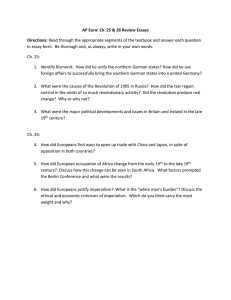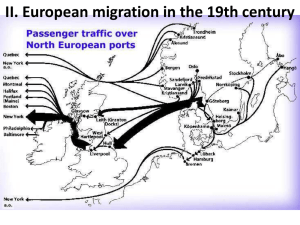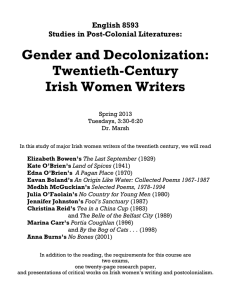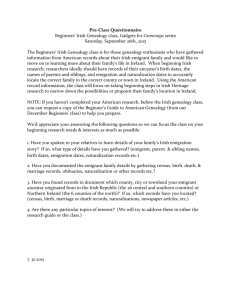European migration in the 19th century - wilsonhginter
advertisement
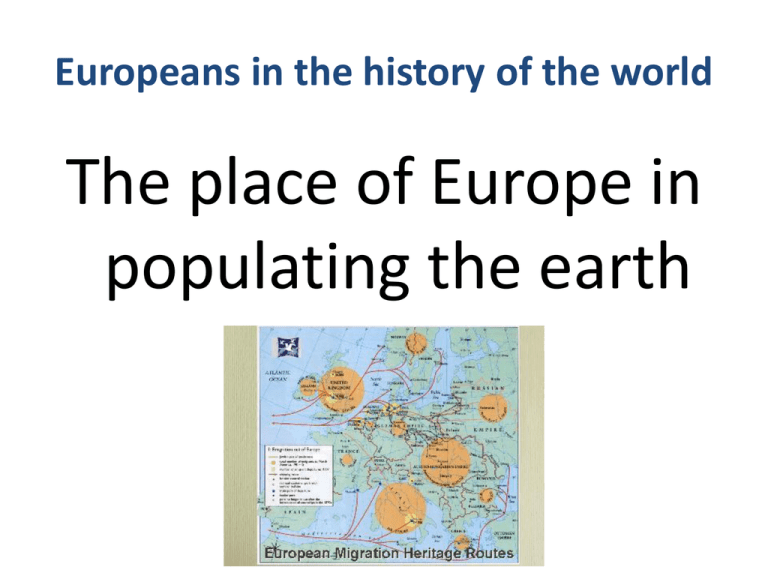
Europeans in the history of the world The place of Europe in populating the earth History of Migratory Movements in Europe Peopling North America: Population Movements & Migration European migration across the Atlantic, beginning in the late fifteenth century, was not an anomaly within the European framework. For centuries prior to their arrival in the New World, Europeans had participated in extensive migrations throughout their continent and Asia. They were a mobile people, accustomed to the concepts of movement and migration. In many ways, the initial arrival in the New World by the Europeans and the advent of trans-Atlantic migration served to extend the migratory patterns that were already present in European society. http://www.ucalgary.ca/applied_history/tutor/migrations/F2.html The place of Europe in populating the Earth • Introduction – Since Ancient Greece to the mid 18th c., European population 40 -140 m (x3.5) vs. World population 230 - 650 m (x2.8) – From the 19th c. European population increases considerably great migratory flows of people I. What was the role of Europe in populating the Earth from Antiquity to the 19th century? A. Regular phases of demographic expansion explain the successive migrations 1st Phase 1. The colonization of the Mediterranean basin in Ancient Greece and Rome a. Role of the Greeks around the Mediterranean sea (like frogs around a pond) : transferring of the city elsewhere (e.g. Nice and Agde) b. Role of the Romans: conquests in the West and East and the creation of colonies (e.g; Nimes, Arles, Orange) 2nd Phase 2. End of Ancient World - 1000 A.D. new population movements shake Europe before it begins expanding again in the Mediterranean a. Barbarian invasions lead to the fall of the Roman Empire b. Advances of Islam, from the 8th c. A.D. hold back Christianity 3rd Phase 3. 11th and 13th centuries: most important European movements occur when demographic growth reappears Crusades and Reconquista Crusades and Reconquista 4th Phase 4. 14th Century: Black Plague ravages Europe between 1348 and 1352 marks a break by dramatically slowing down the fragile growth 25 M dead – 1/3 of the population 5th Phase 5. Great discoveries of the Renaissance to the Colonization of other continents Discovery of America (15th century) colonies in North America, Asia and Africa European Colonization: several consequences 1. Setting up of colonies and slave trade 2. Building of Empires and civilizations (15th19th C) 3. Exploitation of resources 4. Imposing languages, religion 5. Coherent societies form progressively detach themselves from the mother country Causes of Colonization • In the 19th century, the colonization of Africa and Asia has a political aspect and responds to an increased need for land due to the rapid demographic growth since the end of the 18th century. Video: Opportunity beckoned in the New World B. How can we explain this growth? • For a long period, limited growth • Traditional democratic regime characterized by a high mortality rate (famine, war, epidemics) and a high birth rate to compensate Change in 18th century: decrease in mortality rate due to agricultural technology reducing famines and progress in hygiene and medecine which reduce the number of epidemics Why did population growth in the world and particularly in Europe increase so rapidly in the 19th century? • Population Growth Since the birth rate remains high, demographic growth is high Key term: malthus = malthusian, malthusianism Definition: demographic behaviour which aims to limit population growth due to fear of scarcity of resources/wealth to be shared Malthus (English scholar) observed that sooner or later population will be checked by famine and disease. That the increase of population is necessarily limited by the means of subsistence, that population does invariably increase when the means of subsistence increase (and vice versa) Blog for History Geography wilsonhginter.wikispaces.com – Click on your class on the right – Download powerpoint presentations – Watch Videos – Access worksheets II. European migration in the 19th century Why do Europeans migrate in the 19th century? Why do Europeans migrate in the 19th century? I. Multiple Reasons for Migrating • Related to industrialization A. In the 19th c, old seasonal migrations and border crossing migrations continue – for agricultural purposes – Up to several hundred km for harvesting – Migrations of skilled workers increase with urban expansion Why do Europeans migrate in the 19th century? B. Industrialization of cities favors rural flight, attracting inhabitants of overpopulated rural areas - New farm machinery destroys employment in the countryside. Why do Europeans migrate in the 19th century? – People migrate first toward large cities then emigrate toward another country (seemingly the only solution possible) European phenomenon with multifarious causes 1. Political migrations develop - after the revolutions of 1831 and 1848 - Germans, Italians and Poles seeking refuge - Various states intervene to accelerate or hinder certain migrations 2. Religious migrations due to persecution After 1880, pogroms push Jews in the Russian Empire to emigrate Def: pogrom= a violent massacre or persecution of an ethnic or religious group, particularly one aimed at Jews. The term, of Russian origin, originally entered the English language to describe 19th and 20th-century attacks on Jews in the Russian Empire; similar attacks against Jews at other times and places also became retrospectively known as pogroms. Immigration numbers reached their peak in late 1850’s Why do Europeans migrate in the 19th century? 2. Europe unequally affected by migrations Economic migrations which increase with unemployment e.g. Irish emigration after Great Famine An emigration of poverty: Irish emigration in the 19th Century A. Ireland: Land of Exodus 1. Product of British colonization • Colonized in 17th Century by Great Britain and annexed to United Kingdom in 1800 • Population majority Catholic to whom is imposed protestant colonizers from England and Scotland An emigration of poverty: Irish emigration in the 19th Century 2. A Poor Country which the Irish flee • • • • Middle Ages: religious migrations of monks to evangelize the continent Modern Era migrations for religious and military reasons (e.g. Barry Lyndon), 18th century for economic reasons Up to 1815, around 11,000 people per year emigrated to Great Britain but also towards America Between 1815 and 1848, 1 million Irish cross the Atlantic and 500,000 leave for Great Britain – Beginning of the “great emigration of paupers” An emigration of poverty: Irish emigration in the 19th Century 2. A Poor Country which the Irish flee (cont’d) • Irish immigrants of first half of 19th Century : proletariats doing the hardest labor (terracing, drainage, building mining galleries…) (e.g. Erie Canal in Great Lakes region) • Vast majority wind up in packed urban ghettos – their arrival is very poorly viewed by the Anglo-Saxon population (in U.S. and U.K.) An emigration of poverty: Irish emigration in the 19th Century B. The Great Irish Exodus (1845-1890) 1. Why does emigration increase? • From 1845-1854, around 2.3 M leave Ireland, more than 200,000/year for 5 yrs • Potato Blight (food staple of Irish population) causes a famine which leads to 1 million deaths and incites more than a million Irish to emigrate to the U.S. (the poorest flee to G.B.) Potato Production during the Great Famine 1844-1857 An emigration of poverty: Irish emigration in the 19th Century Emigration continues over the years, despite the depopulation of the Island Due to a series of bad harvests, evictions multiply, generating numerous departures which remain significant until the 1890’s. • eviction of 300 tenants by Mrs. Gerrard from the village of Ballinglass, Co Galway, on March 13, 1846 Immigrants arriving in New York Harbor Arrival in Ellis Island, NY harbor An emigration of poverty: Irish emigration in the 19th Century 2. Irish Integration in U.S. society •They swell the ranks of urban proletariats and their social ascension is slow •Poorly viewed by Anglo Saxon Protestants who reject them • Like Italians, the Irish are accused of threatening the basis of the American nation because of their Catholic faith (loyal to the Pope, Political Machines…) Populate urban slums called tenements where misery, lawlessness and poor hygienic conditions reign Dilapidated Golden Flats Tenement slum housing Squalid Living Conditions Cramped living quarters Gangs of New York Rioting in New York An emigration of poverty: Irish emigration in the 19th Century • Circa 1870 Irish immigrants have settled in large Northern cities (New York, Boston, Chicago); • obtain social integration thanks to trade union movement and political life (Democratic Party) • In 1880, New York elects its first Irish Catholic mayor • Some success stories (e.g. Ford) • In 1960, John Fitzgerald Kennedy, the first Catholic President descendant from Irish immigrants, is elected • Today 15-20 million Americans have Irish origins
